built at Phoenix Powered Parachutes to specifications provided by Baron Tayler

Falcon was built in 2007, and is an Experimental Light Sport Aircraft.
In this photo the parachute bag is stowed in the rear seat.

This is another view with the parachute bag sitting next to the PPC.
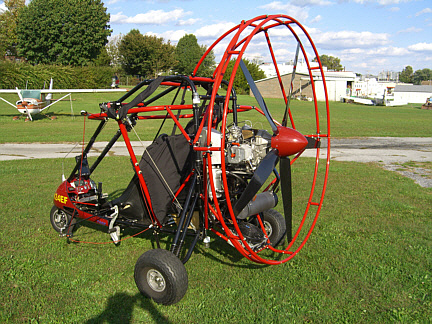
Falcon from behind, with the parachute stowed in the rear seat.
You may have noticed the dual steering foot controls. They will
be removed before Falcon is sold.

Another view from the rear, with the chute bag removed from thr rear seat.
The large spinner on the rear of the prop hub reduces drag.

A view of the Falcon straight-on. This PPC was designed
from the ground up with safety in mind. The dual frontal
bars create a roll-cage in the event of an accident. The frame
is made of the strongest tubing available. But safety doesn't
have to mean ugly. This PPC is easy on the eyes.
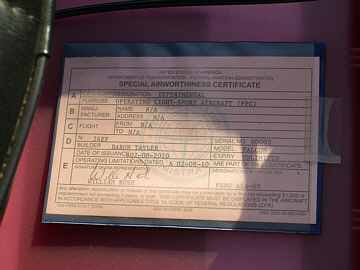
Falcon's Special Airworthiness Certificate.
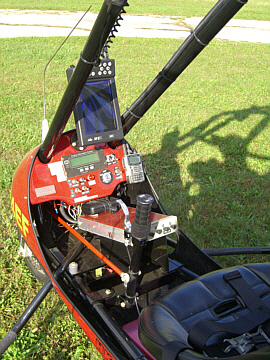
Falcon's intrument panel. Most small GA aircraft don't have
this level of instrumentation. There's an Av-Map moving map
GPS, Grand Rapids EIS, Vertex radio, and even a Mode C
transponder for flying in controlled airspace. Please notice that
the radio "push to talk" is located conveniently on the left frontal
bar, at shoulder level.

A close-up shows the intuitive lay-out of the instruments,
helping you spend less time figuring out what you're reading,
leaving you more time to enjoy flying.

No "intimate" seating in the Falcon. The pilot and passenger
have plenty of room. On most PPCs the passenger seat seems
to have been an afterthought, or almost non-existant, A
passenger on Falcon has lots of leg room. Both the pilot
and the passenger are held securely with over-the-shoulder
harnesses, that go over both shoulders.
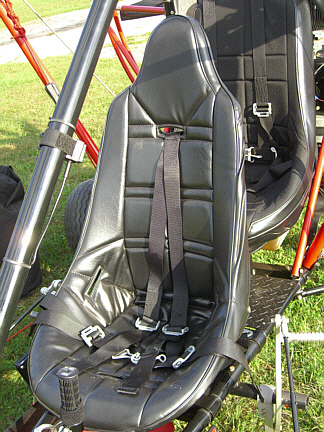
A close-up of the seats. An excellent example of the
fusion of comfort and safety.

The rear of the Falcon is definitely impressive. The 5 blade
72 inch PowerFin prop, coupled with the 4 stroke reliability
of the 60hp HKS engine, produces plenty of thrust.

A close-up of the HKS engine from the left side. The tuned
muffler and the oil tank are visible.

A close-up of the HKS engine from the right side. Notice the cooling fins
on the cylinders. The HKS is air-cooled, meaning you don't have the
weight of the radiator and the coolant, nor the trouble with coolant leaks.

The rear seat doubles as the fuel tank. Innovation at
its finest. The tank holds 14 gallons of fuel.

Falcon has the best line trimmers available. These are the
same trimmers used on the America's Cup yachts. Very easy
and intuitive to use.

Falcon has a disk brake on the front wheel. Meant to be used
while warming up before takeoff, and when rolling at slow speed.

The throttle is the single most important control on a PPC. The
quadrant throttle is very easy to use, and allows for accurate
input, so you can control the engine speed precisely. It is
positioned perfectly, right where your hand naturally rests,
making it effortless and natural to access.

Front wheel steering and the front disk brake are located
conveniently right between your legs. A gentle push or pull
to go right or left (on the ground, of course!). This photo also
shows the transponder on the left, as well as the red plastic
document holder on the floor of the PPC. The document
holder contains the registration, operating limitations, weight
and balance document and the aircraft logbooks.

An interesting feature on Falcon is its custom oversize oil cooler.
Although it has a thermostatically operated fan, that feature is
never used, because the engine never gets that hot.

One of the most unique features on Falcon are the steering bars.
Notice that they are curved, and drop down, allowing the pilot to
sit with their legs in a natural position. None of this "knees doubled
up under your chin" while you fly. Flying should be safe, fun and
just as important, comfortable.
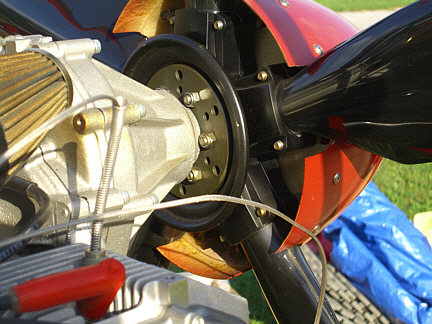
Sometimes it's the little things that make all the difference. For example,
notice the round black object located between the prop attachment plate
and the prop hub. That's a Balance Master, and they are one of the greatest
items ever invented. Any residual vibration caused by your prop will be
eliminated by the Balance Master.
Falcon is ready to fly:
Valid N number and Airworthiness Certificate
Recently inspected
Grand Rapids EIS
AvMap moving GPS with 7.5 inch screen
Vertex radio with Push to Talk
Mode C transponder
PD 550 chute
5 blade 72" PowerFin prop
HKS 4 Stroke Engine with only 80 hours. (1,000 hr TBO.)
14 gallon fuel tank
Dual fuel pumps
Line socks and chute bag
Commtronics dual intercom system
Length: 10 feet
Width: 6 feet 9 inches
Height: 7 feet 2 inches
Weight: 420 pounds